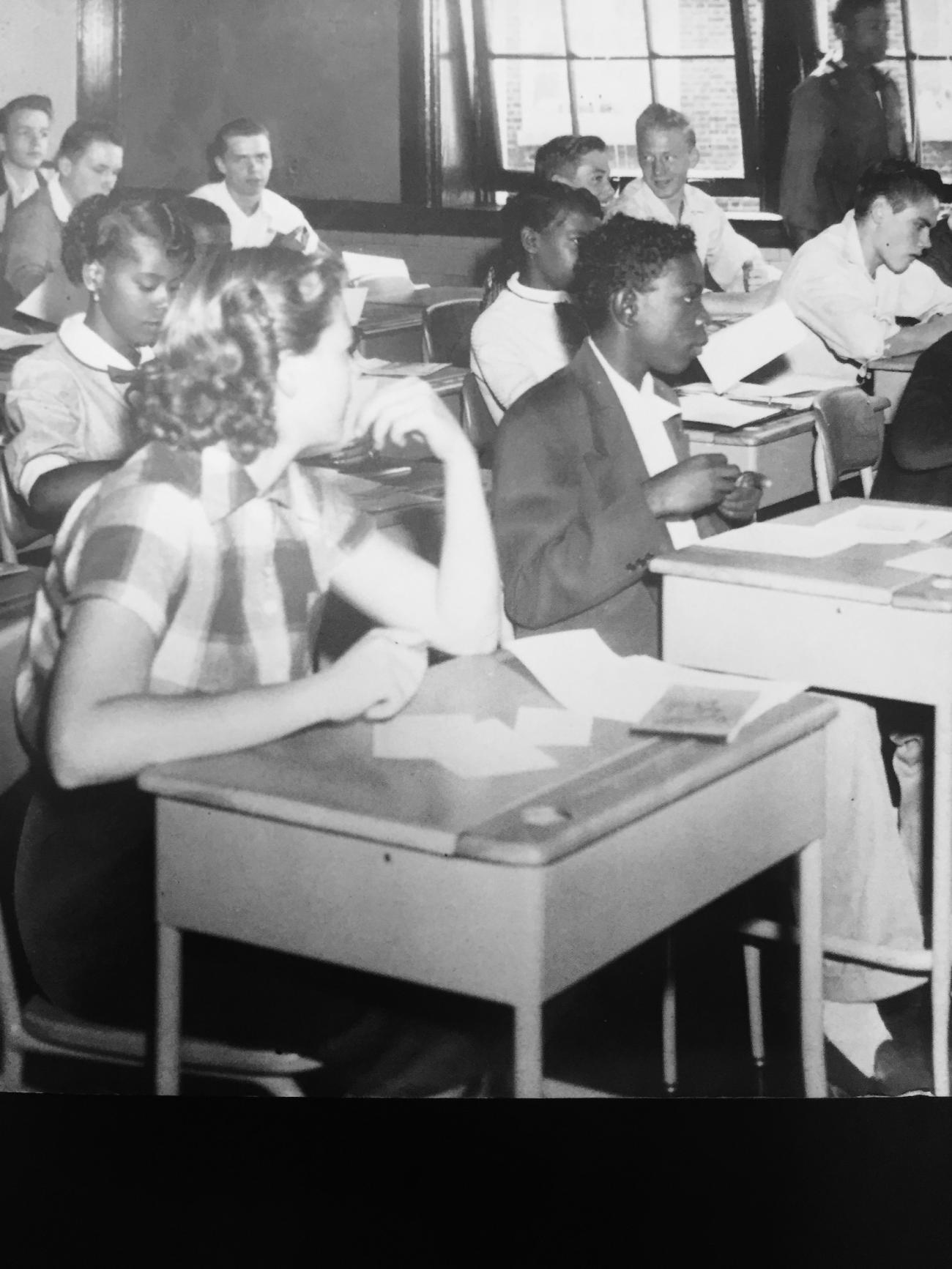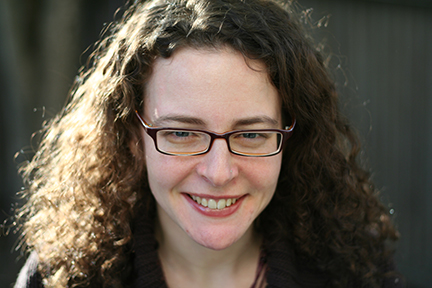
Stanford GSE historian explores shift in understanding of sources and solutions for racial injustice
Leah Gordon’s new book, From Power to Prejudice: The Rise of Racial Individualism in Midcentury America, highlights a little-explored dimension of a common problem: The American tendency to ask schools to resolve the nation’s most vexing social ills.
In the book, Gordon, assistant professor of education at Stanford, examines Americans' debates about the nature and sources of racial oppression and injustice — debates where questions about the role education can, and cannot, productively play in the fight against racism often emerged.
 The book examines individualistic approaches to fighting for improved race relations, techniques such as anti-prejudice education whose proponents assume one could secure racial justice by changing white minds without attacking the social or economic structures undergirding white supremacy, and it asks how and why they became so popular in the mid-20th century. It also discusses how the rise of this individualistic approach to racial reform coincided with a marked shift in scholars’ efforts to explain the sources of racial injustice: Economic and political explanations fell out of favor, while psychology and the individual became central areas for inquiry.
The book examines individualistic approaches to fighting for improved race relations, techniques such as anti-prejudice education whose proponents assume one could secure racial justice by changing white minds without attacking the social or economic structures undergirding white supremacy, and it asks how and why they became so popular in the mid-20th century. It also discusses how the rise of this individualistic approach to racial reform coincided with a marked shift in scholars’ efforts to explain the sources of racial injustice: Economic and political explanations fell out of favor, while psychology and the individual became central areas for inquiry.
“I felt that historicizing anti-prejudice education and the debates around it could offer valuable insights because it was an important but insufficient strategy,” she said. “Obviously promoting tolerance is a crucial task, but it is not a sufficient response to the multifaceted, partly political and economic, problem of racial oppression and white supremacy.“
In researching and writing the book, Gordon, who joined the faculty of Stanford Graduate School of Education in 2008, drew on three areas of her expertise: the history of social science, African-American intellectual history and the history of American education. The resulting work offers a complex portrait of the thorny problem of linking social theory and advocacy for social justice. Gordon addresses both the ways academic research on racial injustice influenced civil rights strategies and the politics of knowledge production, the intersecting intellectual and political dynamics that shaped academics’ scholarly choices.
“How we understand the nature of a social problem and its sources is profoundly important to how we think about solutions,” Gordon said. The book was published in 2015 by University of Chicago Press.
What follows is a transcribed interview with Gordon that was adapted for publication.
What led you to embark on this book?
Leah Gordon: I came to this project from the sense that our current tendency to discuss racism in terms of prejudice — to focus only on how white people feel about racial minorities, has important limitations. There is a long intellectual history where civil rights activists presented racism as a problem that involved politics and economics as well as prejudice and discriminatory legal structures; over that time many viewed the race issue as a multifaceted, structural problem that was inseparable from notions of oppression and exploitation. Yet such perspectives too infrequently emerge in our public conversation. I wanted to use history to try to figure out how that happened.
Have other historians chronicled this development?
LG: Much of the scholarship that my book built on argues that between the 1920s and the end of World War II a number of different ways of understanding racial injustice competed. By the post-World War II years, however, psychological and rights oriented approaches to understanding the race issue — which each relied on individualistic assumptions — gained traction while social structural and political economic theories moved to the margins. My book asks how and why there was this turn to the individual in research on racial injustice.
In the 1920s, 1930s and 1940s, for example four primary ways of explaining the nature and sources of racial injustice competed. One approach was psychological, including theories that, at the extreme, presented racism as a personal malady, a psychological disorder. Theories by scholars such as Harvard social psychologist Gordon Allport frequently implied that the race issue can be reduced to prejudice and that prejudice originated from natural cognitive patterns and behavioral tendencies.
These years also saw a strong strand of rights-based individualism, which the mainstream civil rights movement prioritized; this approach put efforts to secure African Americans’ civil rights through legal desegregation and antidiscrimination legislation at the center of the civil rights struggle.
Finally a number of sociologists and anthropologists in the 1920s and 1930s embraced social-structural and political-economic frameworks. These approaches saw the sources of racial injustice as resting outside the individual minds. In these views the race issue was inextricably tied to intergroup competition, political oppression and labor exploitation.
In the two decades after World War II, the psychological and legal approaches gained traction while social structural and political economic frameworks moved to the margins. My interest was how and why that happened.
You coin a term — “racial individualism” — to describe the two conceptual approaches that dominated discussions of racial justice and equality from the late 1940s to the early 1960s in. What are its implications?
LG: I developed the term “racial individualism” to describe a set of theories that viewed prejudiced attitudes and discriminatory actions as the root cause of racial conflict. These theories suggest that racial justice can be secured by changing the minds of discriminating individuals through education and by protecting the rights of African American individuals in the face of unreformed bigots or their unjust laws.
Racial individualism accomplished a great deal in struggles for racial justice and, as recent examples of police brutality make all too clear, these frameworks are essential for explaining some dimensions of white supremacy. The problem is that focusing only on white prejudice and individual civil rights also leaves important work for racial justice undone, since this approach fails to adequately address the enduring structural dimensions of racial inequality. The history of racial individualism is important because this view of the race issue failed to effectively fight racialized poverty and inequality, proved limited in struggles against extra-legal segregation, and suggested that by securing formal equality (equality before the law) “the race problem” had been solved. This approach also lay some of the theoretical groundwork for contemporary colorblindness, a legal framework that has been limiting progress towards racial justice and equality by suggesting that the only important racial harms are intentional.
What did your study of the social science scholarship at historically black colleges and universities, or HBCUs, reveal?
LG: One issue my research highlights is that African American-led intellectual spaces nurtured crucial challenges to the often incomplete ways of viewing racial oppression circulating in elite white research institutions. In an era when the academy was, with a few exceptions, still segregated, the differences in the types of discussions occurring in elite HBCUs and in elite white institutions are not surprising.
Still, I was struck by the extent to which discourse around oppression and exploitation remained in African-American intellectual settings that I examined while it was much less common in the white ones.
My book explores the dangers of epistemic marginalization, in which entire ways of viewing a social problem are overlooked because their proponents don’t have seats at the agenda setting tables. I hope my work will highlight the importance of minority-led intellectual spaces and raise questions about how those spaces can be protected in integrated universities. There was a counter narrative about racial injustice that flourished at elite HBCUS, places like Fisk and Howard Universities, that became the foundation of the theories of institutional racism that reemerged among Black Power activists and then slowly among white liberal sociologists in the mid and late 1960s. While these structural theories had declined in the white academy in the Cold War era, they never went away at the HBCUs.
Did scholars at places like Howard and Fisk completely reject “racial individualism?”
LG: Here is where I want to separate legal desegregation from the attitudes-based approach and the psychological individualism that together comprise racial individualism. In the years before Brown v. Board Education had overturned legal segregation, scholars at African-American institutions — for obvious reasons —ubiquitously embraced a rights-based approach. They recognized that the legal basis of segregation had to be eliminated, even if other work would remain after civil rights were secured. But many rejected the notion that you can change socioeconomic or political structures by changing white attitudes. Many agreed with sociologist E. Franklin Frazier, who criticized efforts to secure racial justice by promoting white tolerance. As Frazier put it in 1924, “The Negro does not want love [meaning sympathy, support and charity from white people]. He wants justice.”
What does your chapter on the National Council of Christian & Jews show about anti-prejudice education efforts?
LG: They were an organization that had started out focusing on interreligious relations. By the mid-1940s in response to the Nazi crisis and a series of urban racial disturbances at home, alongside widespread concern with fighting a segregated war for freedom, they start dealing with racial issues, but said again and again that they are not going to move into the political realm and they won't engage in what they term “propagandistic” activities. The group’s anti-prejudice work involved things like “Brotherhood Week” and media campaigns promoting racial tolerance. They also had roundtables where people of different religious and racial groups came together to talk, to get out their differences and to achieve a sort of catharsis.
The surprising thing about the National Conference of Christians and Jews is that although the main focus of their work was promoting tolerance and fighting prejudice, when the Brown v. Board of Education ruling was made, NCCJ leaders, in the national office, were afraid that they were going to lose their Southern members. They decide that it was institutionally in their best interest to keep the allegiance of what they termed “the Southern moderate,” who was a gradualist on desegregation. The NCCJ, then, exemplifies the limits of fighting racism by only attacking prejudice, because in some extreme cases this justified a refusal to support even basic civil rights measures like legal desegregation.
During the period your book discusses, major shifts were occurring in the social sciences. How did that affect how intellectuals approached the race issue?
LG: There was a turn to behavioralism across the social sciences that began during and accelerated in the decade following World War II. This interdisciplinary approach brought together psychology, sociology and anthropology to deal with questions about individual minds, interpersonal interactions and group behavior. It tended, however, to address those issues without reference to the political context and economics. When I talk about the pressures that pushed scholars towards individualistic ways of thinking about the race issue, the growing stature of the interdisciplinary behavioral sciences is one.
What historians sometimes call “the behavioral sciences revolution” had a lot of money and status behind it. I have a chapter on the Rockefeller Foundation, which had been fairly conservative in its approach to racial issues, but had been willing to support work on race in the 1920s that had a political-economic orientation alongside other approaches. By the early 1950s, the only work that I could find the foundation funding related to race was work associated with human relations, a term often used to describe this new hot field — the behavioral sciences.
The post-war years were also an era of scientism, a term that describes social-scientific reliance on the investigative norms of the natural sciences. At places like the Rockefeller Foundation, scholars interested in studying race relations were very worried about what they called “particularism,” a term they associated with research on specific communities that could not be generalized. While much interwar research on race had involved focused community studies, advocates of postwar scientism, who held a lot of power in leading foundations and universities, worried this approach was too narrow. Many believed the purpose of social scientific investigation was to develop generalizable theories and abstract knowledge. When it came to the study of race relations, many scholars were largely interested in research that could discern natural laws of group interaction. This kind of research required a large data set and individuals were easier to study at a large scale than communities. Robin M. Williams, a sociologists from Cornell whom I write about, at one point expressed these hopes for generalizability in research on race:, Eventually, he hoped scholars would “not be studying Negro-white relations, Catholic-Protestant relations, Irish-Polish relations — but we shall be analyzing the relations between differently situated and differently categorized persons and selecting our cases wherever found on the basis of strategic interest to social science.”
In addition to the internal dynamics affecting scholarly trends, how did the politics of the day affect social science?
LG: Ultimately it was not a coincidence that so many scholars embraced behavioral frameworks that avoided economics at the height of McCarthyism. In fact, the leading foundations were under investigation by McCarthyists in Congress in the early 1950s, many universities saw anticommunist witch hunts, and some on the right treated any research on race, or on political economy, as potentially subversive. So there were political as well as intellectual pressures favoring racial individualism.
How does your book help to understand the role academia can play in promoting change?
LG: I really tried to explore something I see as the dilemma of the mid-century scholar-activist. Many of the social scientists and activists — people working in labor unions, social welfare organizations, civil rights groups, teachers — had high hopes for using social science to inform racial activism and racial politics.
Yet the reality proved much more complicated than they envisioned. Reformers have to be pragmatic while social theorists and social scientists don't. In many of the settings I looked at, there emerged a real discrepancy between the theory of the race issue that many of the scholars I was looking at developed and their visions for what to do immediately, which had to take into account the political climate and the political possibilities.
Williams, the sociologist I mentioned earlier, put it very well: “Not all causes of a social problem are appropriate levers of change.”
Do we see racial individualism or critiques of it in contemporary debates about racism?
LG: Contemporary antiracist struggles, which are of course varied in their priorities, tend to acknowledge that both individual bias and the systemic, structural and political-economic dimensions of racial injustice demand action. Many recent protests against police brutality, for example, make clear that white prejudice, whether conscious or unconscious, continues to have deadly consequences. But the uprisings in Ferguson and Baltimore, and many of the Black Lives Matter protests on and off campus, have also built on the language of institutional and structural racism. This language, which itself had a long history but gained considerable attention outside academic and radical circles in the Black Power era, emphasized that even in the era of “formal equality” (equality before the law) racial oppression involves more than individual prejudice and discrimination — it also involves systemic, structural and institutionalized racism.
Many of the antiracist activists we are seeing on the news today present police misconduct as not an exceptional series of incidents but as a systemic and institutional problem. In addition, many of the protests we’ve seen have made clear that if we want to fight for racial justice we need to start but we cannot stop with police brutality. We also need to fight profoundly underfunded schools, troubling school-to-prison pipelines, the crisis of mass incarceration, the economic marginalization of many inner-city and poor suburban communities, unemployment, the absence of a living wage and the tattered social safety net. So today’s antiracist activists are both employing the useful elements of racial individualism in identifying the deadly consequences of bias, prejudice and individual acts of discrimination while also going beyond the limits of individualistic frameworks by pointing to systemic, structural and institutionalized injustice. I hope our policy makers listen.



